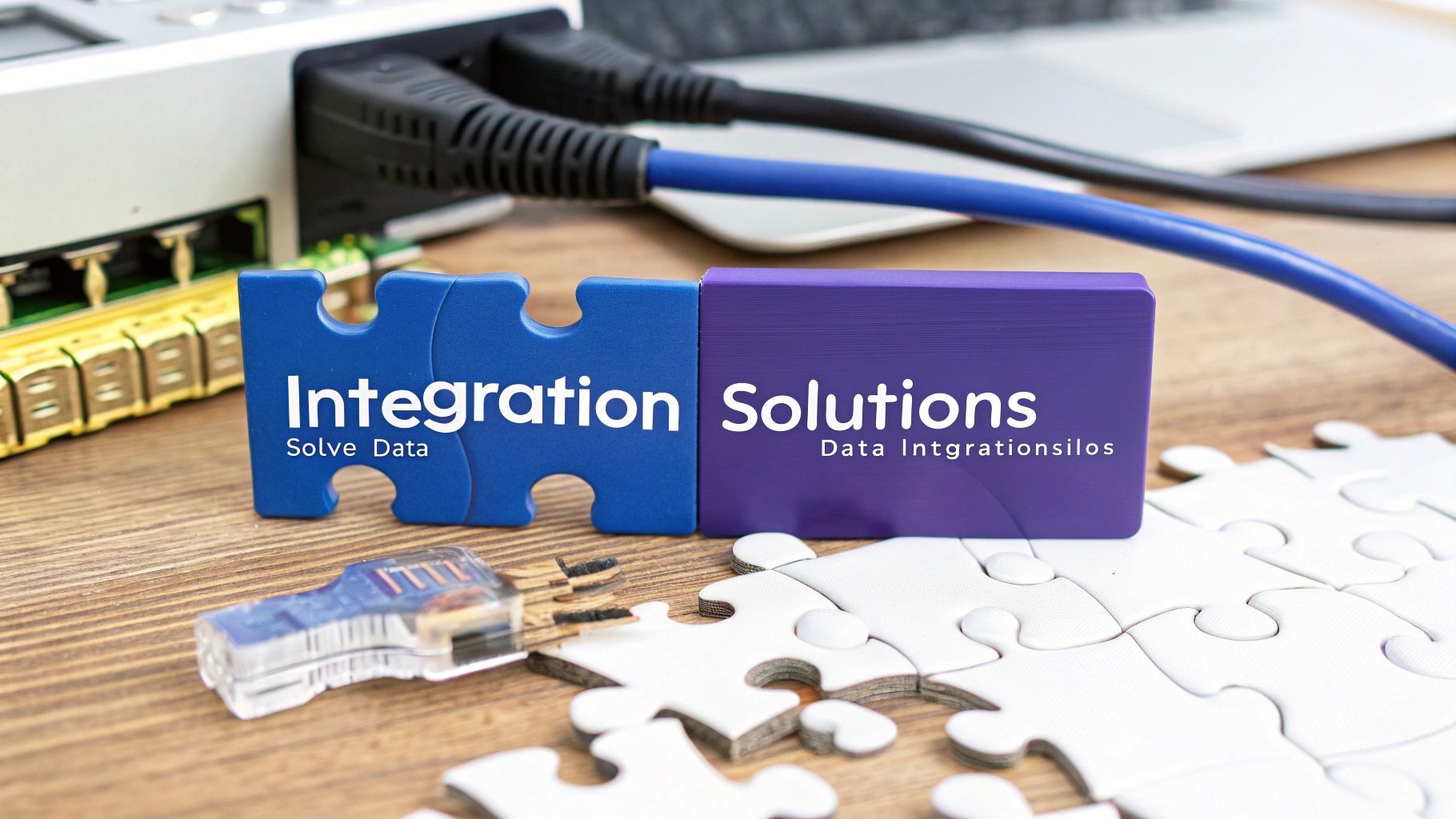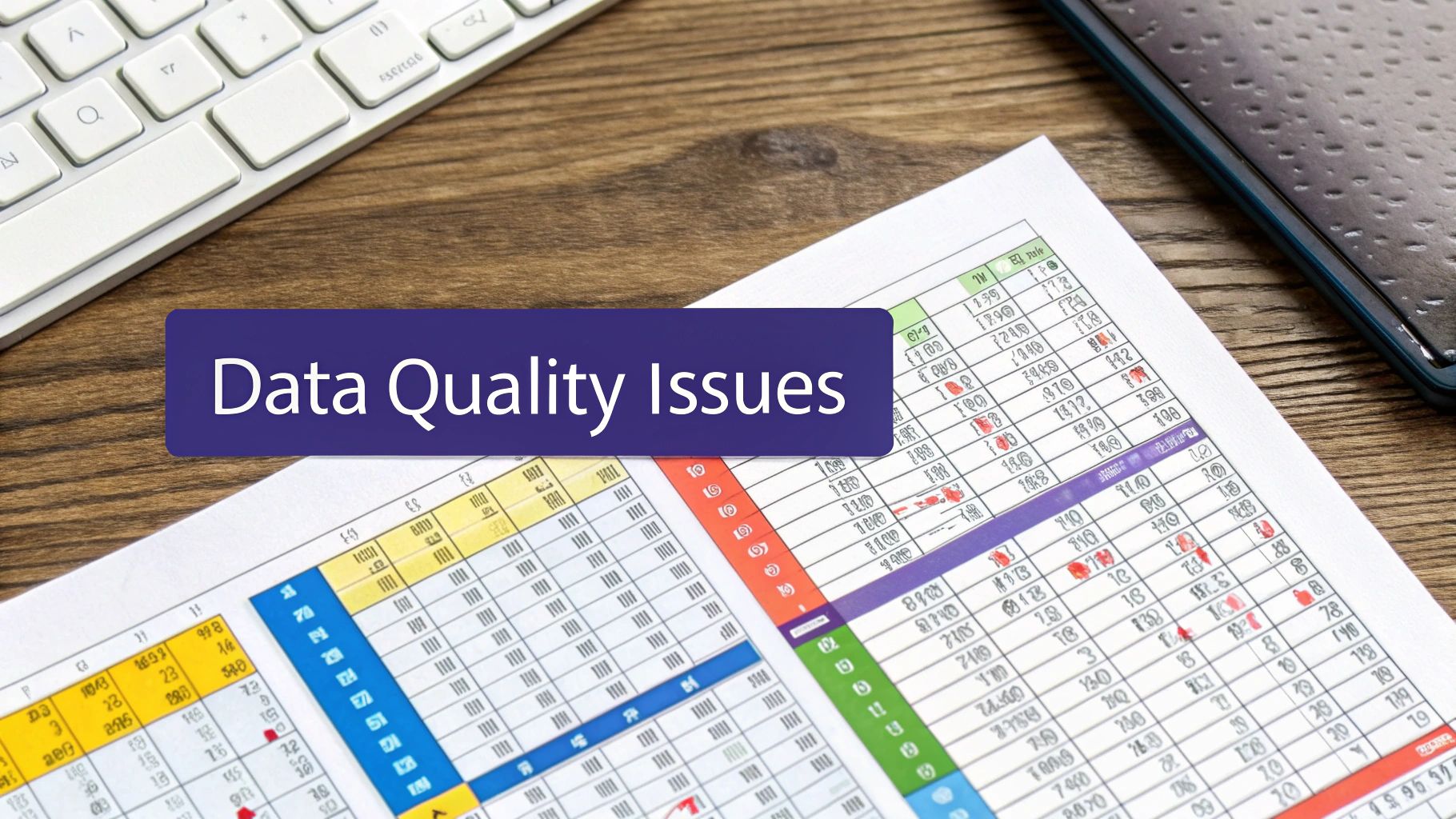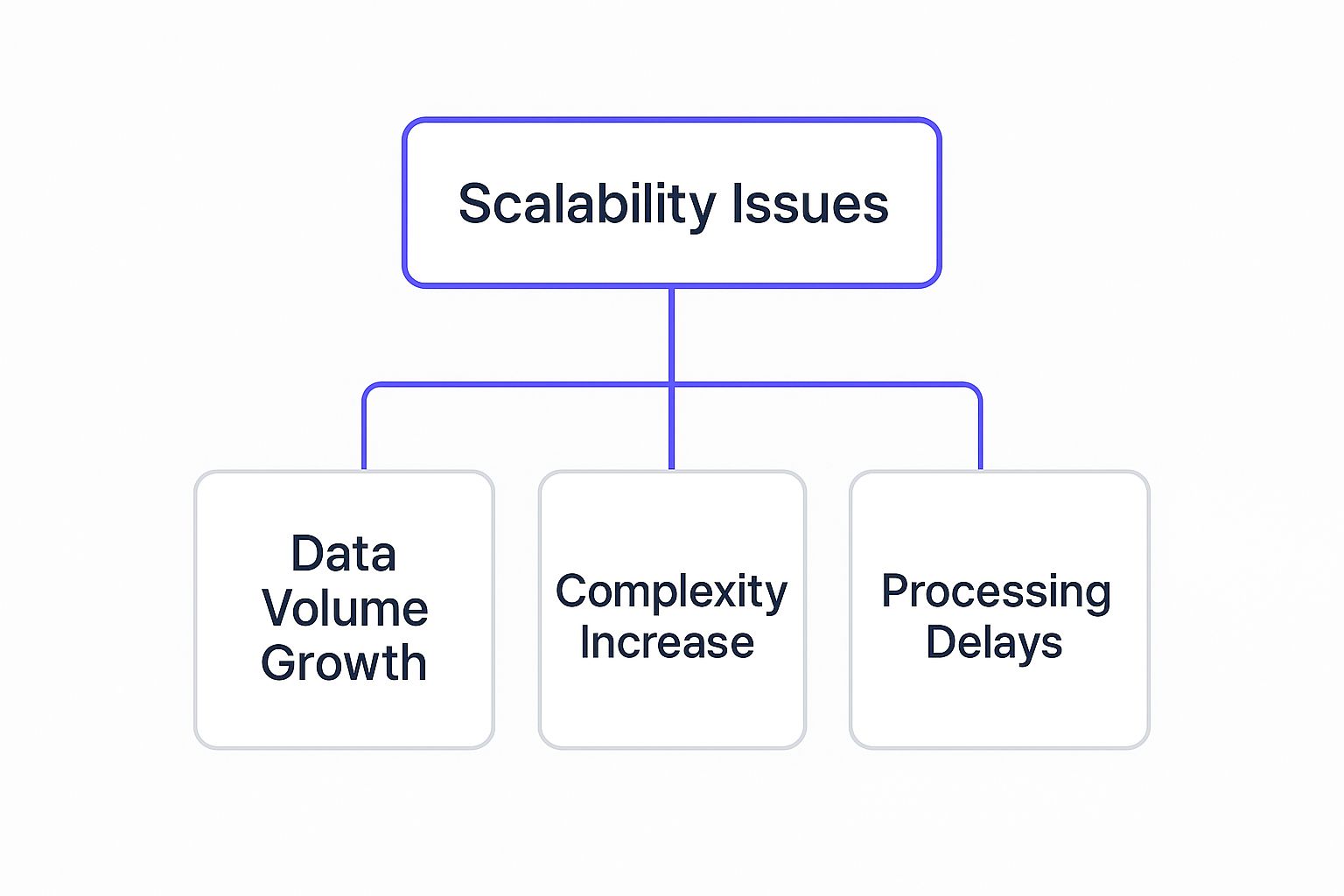Solving Common Data Integration Problems
Tired of messy, siloed data? This guide explores the most common data integration problems and offers actionable strategies to create a unified data ecosystem.

Data integration problems can be a massive business bottleneck that can choke growth and rack up costly mistakes. When your data is scattered across different systems and can't talk to each other, it puts a drag on everything from daily operations to big-picture strategic planning. Getting this right is fundamental to unlocking what your company is truly capable of.
Why Disconnected Data Is Costing Your Business
Imagine trying to cook a five-star meal, but all your ingredients are locked away in separate pantries. Marketing has the fresh vegetables, your sales team has the prime cuts of meat, and the finance department is guarding the spices. You have all the high-quality components, but without a way to bring them together, you can't possibly create a coherent, delicious dish.
This is exactly what happens in a business struggling with poor data integration.
When data is disconnected, you're left with a fractured view of reality. This forces your teams to make critical decisions with only a sliver of the full picture. The fallout? Wasted resources, missed opportunities, and a clunky customer experience. For instance, your marketing team might be pouring money into campaigns targeting customers who have already churned—a fact your support system knows all too well. Or the sales team might miss obvious upsell opportunities that are buried in support ticket data.
The Hidden Costs of Data Fragmentation
The financial hit from these disconnects is very real. Even on a tactical level, simple failures like not integrating marketing conversion data with e-commerce platforms can lead to poor ad spend and flawed decision-making.
These issues are so common that the global data integration market is expected to hit a staggering USD 35.08 billion by 2033. This massive growth isn't just a number; it signals an urgent, widespread need for businesses to get their data in order and overcome hurdles like poor quality and system incompatibilities.
This guide will break down the most common data integration problems and give you clear, actionable ways to fix them. First, here’s a quick look at the core challenges and the real-world impact they have on business.
Data Integration Challenges and Their Business Impact
Here's a quick look at the core data integration problems and the tangible negative effects they have on an organization's success.
Integration ProblemPrimary Business ImpactData SilosIncomplete customer view and duplicated efforts.Poor Data QualityFlawed analytics and loss of trust in data.High Data VolumeSlow decision-making due to processing delays.Format MismatchesWasted time on manual data cleaning and errors.
As you can see, these aren't just IT issues. They're business issues that directly affect your bottom line and ability to compete. Now, let's dive into each one.
Dismantling The Data Silo Trap

Of all the hurdles in data integration, the data silo is probably the most common—and the most frustrating. It’s a classic trap.
Think of each department in your company as its own little island. Sales Island speaks CRM, Marketing Island uses its own analytics dialect, and Finance Island has its own ERP-based vocabulary. They all function just fine on their own, but they can't talk to each other. This setup makes getting a unified view of the business practically impossible.
Data silos don't just appear out of nowhere. They grow organically. Your marketing team picks the best tool for their campaigns. Your finance team chooses another one optimized for accounting. Before you know it, you've got valuable historical data held hostage in legacy systems from a decade ago. Without a central data strategy, these separate systems harden into fortresses of information.
The Real-World Consequences Of Silos
When your data is scattered, you're essentially flying blind. The consequences of these silos hit your bottom line and customer experience directly.
- Duplicated Efforts: Your sales and marketing teams might both be chasing the same at-risk customer, completely unaware of what the other is doing. Wasted time, wasted money.
- Missed Opportunities: The product team could be missing game-changing feedback buried deep in customer support tickets, leading them to build features nobody asked for.
- Fractured Customer Journey: A customer gets a marketing email promoting a product they just complained about to your support team. It’s a jarring experience that screams, "we don't have our act together."
This fragmented view makes it incredibly difficult to answer the big questions. For example, you can't build a reliable model to predict customer churn when the warning signs are scattered across a half-dozen disconnected systems.
A siloed organization can never achieve a true 360-degree customer view. It’s like trying to understand a person by only looking at their left foot—you’re missing the entire context.
How To Break Down The Barriers
Tearing down data silos isn’t just about connecting a few pipes. It’s a mix of the right tech, a smart strategy, and a shift in company culture. You’re not just moving data; you're building bridges between teams so everyone can work from a single source of truth they actually trust.
For a practical look at how these principles apply within a specific department, this accounting software integration guide offers some fantastic, transferable insights.
Ready to get started? Here are some actionable strategies:
- Establish a Unified Data Governance Framework: First things first, you need to create clear rules for how data is defined, stored, and accessed. This gets everyone speaking the same data language, no matter which department they're in.
- Foster a Culture of Data Sharing: This has to come from the top. Leadership needs to champion the idea that data is a shared company asset, not a departmental toy. Encourage cross-functional projects that rely on shared data to show everyone what’s possible when you work together.
- Implement a Central Data Hub: Use a modern solution like a data warehouse or a lakehouse to bring all your information together. This hub becomes the central meeting point for all your little data islands, finally creating one unified continent of information.
Tackling Data Quality and Consistency

So you’ve managed to break down every data silo, and information is finally flowing between your systems. That's a huge win, but your work isn't done yet. If that information is unreliable, all your hard work is for nothing.
This brings us to one of the most destructive problems in data integration: poor data quality. It’s the classic "garbage in, garbage out" scenario. When you feed your analytics engine flawed data, you're guaranteed to get flawed insights.
This isn’t just a minor headache. Bad data actively erodes trust. When leaders see reports filled with contradictions or glaring errors, they stop believing in the numbers. This skepticism can derail major strategic initiatives and push teams right back to making decisions based on gut feelings instead of hard evidence.
The problems often seem small at first glance. A customer's state is entered as "CA" in one system, "Calif." in another, and "California" in a third. A sales rep accidentally creates a duplicate entry for a key account. A critical field, like a customer's renewal date, is left blank. Individually, they’re just minor slip-ups.
But when you try to bring all this data together, these tiny errors snowball into massive miscalculations. You end up with skewed forecasts, botched marketing campaigns, and frustrating customer interactions.
Building a Strong Data Quality Framework
To fight back, you need a system—a solid data quality framework. This isn't a one-and-done cleanup project. It's an ongoing discipline built on three core pillars that ensure your data stays clean, consistent, and trustworthy.
- Data Profiling: This is your discovery phase. Before you can fix anything, you need to understand the full scope of the problem. Profiling tools scan your source data to uncover all the hidden issues, like finding every variation of a state name or flagging records with missing phone numbers.
- Data Cleansing: Once you've identified the problems, it's time to fix them. This is where you standardize formats (like turning all state variations into the proper two-letter code), merge duplicate records, and fill in missing information where you can.
- Data Validation: This is your line of defense against future errors. By setting up automated validation rules in your integration pipelines, you can catch and flag bad data before it ever pollutes your central systems. For instance, a rule could automatically reject any new customer record that doesn’t have a valid email address format.
As businesses scale, this commitment to quality becomes absolutely critical. To handle the challenges of sourcing data from various systems, many teams rely on data extraction automation tools to ensure the initial data capture is as clean and accurate as possible.
The goal of a data quality framework is simple but powerful: to ensure that every decision-maker, from the CEO to a customer support agent, is working with data they can implicitly trust.
Maintaining Integrity in a Growing Market
The demand for high-quality, integrated data is sending the market soaring. By 2030, the global data integration market is projected to hit USD 33.24 billion, a boom driven by the non-negotiable need for real-time processing and operational efficiency.
This explosive growth shows just how central data integration challenges—especially around quality and consistency—have become for any business that wants to stay competitive.
Ultimately, managing data quality isn't just about cleaning up spreadsheets. It’s about building a reliable foundation for your entire business intelligence strategy and making sure your integrated data is an asset, not a liability.
Managing High Data Volume and Velocity

Trying to manage modern data can feel a lot like trying to drink from a firehose. Every second, a massive torrent of data floods in from social media feeds, real-time transactions, and a sprawling network of IoT devices.
Each day, a staggering 328.77 million terabytes of new data are created. This relentless flow is one of the biggest data integration problems businesses face today.
The sheer scale (volume) and speed (velocity) of this data can easily overwhelm traditional integration methods. Yesterday’s solutions were built for a much slower, more predictable world.
Think about nightly batch updates, where data is collected all day and processed overnight. That just doesn't cut it anymore. In an economy that runs 24/7, waiting until tomorrow for today’s insights means you’re already falling behind. Decisions made on stale data lead to missed opportunities, poor customer experiences, and a serious competitive disadvantage.
The High Cost of Data Latency
When your data infrastructure can't keep up, you start paying a heavy price. This delay between an event happening and you being able to act on it is called data latency, and it has direct consequences for your bottom line.
Imagine a fraud detection system that only flags a suspicious transaction hours after it occurred. By then, the damage is done.
Similarly, a personalized marketing offer that arrives a day after a customer browsed your site has lost all its impact. These delays are symptoms of an outdated infrastructure that simply wasn't designed for the high-volume, high-velocity data of today. The inability to process and integrate data in real time is a major bottleneck that stifles growth and innovation.
Data latency is the silent killer of opportunity. The value of an insight diminishes with every second that passes, and legacy systems that can’t keep up are actively eroding your business's potential.
Modern Architectures for a High-Speed World
To conquer the challenges of volume and velocity, you need a modern data architecture built for speed and scale. This means moving beyond old-school batch processing and embracing technologies designed for a continuous flow of information.
Here’s how leading organizations are taming the data firehose:
- Stream Processing: Instead of collecting data in batches, stream processing handles it in real time, as it arrives. This is essential for any use case that requires immediate action, like live analytics dashboards, real-time personalization engines, and instant fraud alerts.
- Scalable Cloud Platforms: Cloud-based data warehouses and lakehouses give you the flexibility to handle massive and fluctuating data loads without huge upfront investments in physical hardware. They can scale up resources during peak times and scale back down to control costs, providing an elastic foundation for your entire data strategy.
- Event-Driven Architecture: This design pattern treats every new piece of data—like a user click or a sensor reading—as an "event" that can trigger an immediate, automated action. It’s a highly efficient way to build responsive, real-time systems that can react instantly as new information comes in.
Choosing the right tools is critical here. Look for solutions specifically built to handle high-volume data streams. A key feature to look for is real-time change data capture (CDC), which automatically syncs changes from source systems without requiring a full data reload. By adopting these modern approaches, you can transform that overwhelming flow of data from a daunting problem into your most powerful strategic asset.
Harmonizing Different Data Formats and Structures
Imagine trying to get a coherent story from three people at once. One person speaks in precise, formal prose (that’s your structured data). Another talks in slang-filled text messages packed with emojis (semi-structured data). The third just uses vague, expressive hand gestures (unstructured data).
It would be absolute chaos. Yet, this is a perfect picture of one of the biggest technical headaches businesses deal with every single day.
A single company is constantly juggling this motley crew of data types. You've got the neat, orderly rows and columns of structured data from your SQL databases. Then there's the more flexible semi-structured data, like JSON files coming from APIs. And finally, you have the wild, unpredictable world of unstructured data from social media comments, support tickets, and emails.
To get them all to work together, you need a "universal translator"—a process we call data transformation. Without it, your analytics are basically dead in the water. You can't compare hard sales figures from a database with customer feelings pulled from a survey if they can't even speak a common language.

The Data Variety Explosion
This challenge isn't getting any easier. In fact, it's getting worse as new data sources pop up constantly. The data integration market was already valued at around USD 11.4 billion in 2022, and it's projected to keep climbing, mostly because of the explosion of data from IoT devices and social media.
This tidal wave of data variety and volume means you need some serious muscle to make sense of it all. To keep up, many businesses are turning to cloud-based and open-source tools that offer the flexibility and scale they need without a massive upfront investment. You can find more details on this trend in this overview of the data integration market.
Choosing Your Translation Method: ETL vs. ELT
When it comes to actually translating all this data, two main strategies have become the go-to solutions: ETL (Extract, Transform, Load) and its more modern cousin, ELT (Extract, Load, Transform). They might sound almost identical, but their workflows are completely different, and picking the right one is a critical decision.
ETL (Extract, Transform, Load)
This is the old-school, traditional approach. First, data is pulled from its source (Extract). Next, it’s cleaned up and reshaped into a standard format on a separate processing server (Transform). Finally, it’s moved into its destination, like a data warehouse (Load).
- Pros: The data that lands in your warehouse is clean, standardized, and ready for analysis right away. It's a mature, well-understood process that many teams are familiar with.
- Cons: That transformation step can be a real bottleneck, especially when you're dealing with huge datasets. It’s also pretty rigid; if you want to tweak an analysis, you often have to run the entire, time-consuming process all over again.
ELT (Extract, Load, Transform)
This newer method flips the last two steps on their head. Data is extracted from the source and immediately dumped into a powerful cloud data warehouse (Load). All the transformation happens right inside the warehouse, taking advantage of its massive processing power (Transform).
- Pros: It's incredibly fast and can scale almost infinitely, since it’s piggybacking on the performance of modern cloud platforms. It also keeps the raw, untouched data, which gives analysts the freedom to transform it in different ways for different projects.
- Cons: This approach absolutely requires a powerful (and potentially expensive) data warehouse that can handle all that heavy lifting efficiently.
The choice between ETL and ELT really boils down to your infrastructure and what you're trying to accomplish. Think of it this way: ETL is like a meal-kit delivery service that sends you perfectly prepped and portioned ingredients. ELT is like getting a whole pantry of groceries delivered and letting the chef decide what to make on the spot.
Ultimately, getting your different data formats to play nicely is non-negotiable if you want a complete picture of your business. Without a smart translation strategy, your data integration efforts will just create a messy, unusable pile of information instead of a powerful asset that drives smart decisions.
Building Your Future-Proof Data Integration Strategy
Getting a handle on data integration isn't just about fixing problems as they pop up. If you're always reacting, you're always one step behind. Real success comes from thinking ahead and building a strategy that can grow and change right alongside your business.
Think of it less like a one-and-done project and more like a continuous discipline. It's a commitment to creating an architecture that won't become a bottleneck tomorrow. This is about future-proofing your data infrastructure so it remains a genuine asset, not a future liability holding you back. The goal isn't just to connect systems; it's to become a truly data-driven organization.
Pillars of a Resilient Integration Architecture
So, how do you build a strategy that lasts? It all comes down to three core pillars. These pillars work together to give you a flexible, scalable, and trustworthy data foundation. If you neglect one, the whole structure gets wobbly, and you'll find yourself right back where you started. A solid architecture is the engine behind many successful SaaS growth strategies, giving companies the agility to make smarter, faster decisions.
Let's break down the pillars you need to build on.
- Adopt Flexible and Scalable ToolsYour toolkit has to be ready for whatever comes next—not just today's data volume, but tomorrow's too. This means ditching the old, rigid, hard-coded pipelines that are brittle and snap under pressure. Modern platforms like iPaaS (Integration Platform as a Service) and ELT (Extract, Load, Transform) solutions are built for this kind of agility. They’re designed to scale with you and adapt to new data sources without a massive headache.
- Establish Clear Data GovernanceWithout good rules of the road, your shiny new integrated system will turn into chaos. Fast. Data governance is the framework that keeps your data high-quality, consistent, and secure. It’s about assigning clear ownership for different data domains, agreeing on a common vocabulary for key metrics, and creating transparent policies for who can access what. Think of it as the rulebook that ensures everyone is playing the same game.
- Cultivate a Data-First CultureGreat tech and solid rules are only two-thirds of the puzzle. The final, crucial piece is a cultural shift. Data needs to be seen as a shared company asset, not something hoarded by individual departments. This means fostering collaboration between teams, championing data literacy for everyone, and celebrating the wins that come from shared insights. When everyone values data, everyone wins.
Mastering data integration is the foundational step toward becoming a genuinely data-driven organization. It’s about building a system so reliable that every team, from marketing to product, trusts the data enough to use it for their most important decisions. This trust is what transforms data from a simple resource into a competitive advantage.
Your Data Integration Questions Answered
Even with a solid plan in place, specific questions always pop up when you're in the thick of a data integration project. Here are some clear, straightforward answers to the most common queries we hear. Think of this as your go-to reference for reinforcing key concepts and making smart decisions.
What Is The Main Difference Between ETL and ELT?
The biggest difference between ETL (Extract, Transform, Load) and ELT (Extract, Load, Transform) really just boils down to when the data gets changed.
It helps to think about it like cooking.
ETL is like a meal-prep service. Your ingredients (data) are all chopped, seasoned, and prepped (Transformed) in a separate, commercial kitchen (a staging server). Then, the finished meal is delivered to your plate (the data warehouse), ready to eat.
ELT is like having a fully-stocked professional kitchen at home. All the raw ingredients (data) are delivered straight to your kitchen (a cloud data warehouse). You or your analysts can then chop, mix, and cook (Transform) them on the spot, any way you see fit.
ELT has really taken off recently because modern cloud data warehouses have incredible processing power. This makes it much faster and more flexible to just load all the raw data first and transform it right inside the destination system.
How Do I Choose The Right Integration Tool?
Picking the right tool is absolutely critical. Honestly, rushing this decision is one of the most common mistakes we see, and it almost always leads to bigger data integration problems later on.
Before you commit to a tool, run through this practical checklist:
- Source and Destination Compatibility: This is non-negotiable. Does the tool have pre-built connectors for all the apps, databases, and platforms you rely on? If not, keep looking.
- Scalability: Can the tool handle your data volume today and grow with you over the next few years? Think about both the amount of data and the number of sources you plan to add.
- Total Cost of Ownership (TCO): Don't just look at the sticker price. You need to factor in the costs of implementation, ongoing maintenance, and the people-hours required to operate it.
- Real-Time Needs: Does your business depend on instant data? If you need up-to-the-second syncing, make sure the tool supports real-time methods like Change Data Capture (CDC).
How Can AI Help With Data Integration?
Artificial Intelligence and Machine Learning are becoming absolute game-changers for solving the thorniest integration challenges. Instead of burning hours on manual, repetitive work, AI can automate and streamline some of the most time-consuming tasks.
For example, AI algorithms can intelligently scan different data sources and suggest how to connect them, a process known as automated schema mapping. They can also monitor data streams in real time to spot and flag quality issues or weird anomalies before they contaminate your downstream systems.
AI is also fantastic for data cleansing, as it can identify patterns in messy, inconsistent data and apply corrections automatically. When your goal is to create better user journeys, AI-powered integration is the key to being able to optimize the customer experience with clean, timely, and reliable data.
At Surva.ai, we understand that actionable insights begin with great data. Our AI-powered survey platform helps SaaS teams collect, analyze, and act on customer feedback to reduce churn and drive growth. Turn your user feedback into your most valuable asset. Learn how Surva.ai can help you scale smarter.


